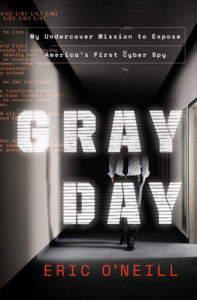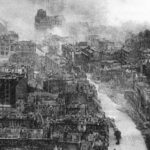In January 1976, Robert Hanssen joined the FBI.
His credentials as a certified public accountant with a master’s degree in business administration complemented four years spent on the Chicago police force to make him a good fit for the agency’s Financial Crimes Division, and he was assigned to Gary, Indiana, right out of the FBI Academy. But even as Hanssen investigated white-collar criminals in the Midwest, he was dreaming of bigger things. Hanssen had grown up with a fondness for espionage. He devoured James Bond books and movies. He bought a Walther PPK pistol, a Leica spy camera, and a shortwave radio to flesh out the fantasy. He even opened a Swiss bank account. But 007 didn’t belong in Lake County, Indiana.
After two years, the FBI signed off on Hanssen’s transfer request to New York City, one of the great spy capitals of the world. Hanssen found his calling within the Soviet Counterintelligence Analytical Squad. His early supervisors described him as smart, technically proficient, and analytical, and they marveled at his ability with computer systems. They also considered him lacking in field operations ability and assigned him to administrative work, crushing his James Bond fantasies. Instead of working undercover against Soviet spies on the streets of Gotham, Hanssen managed the New York Field Office’s counterintelligence database. He joined the FBI to hunt spies. The FBI made him a librarian.
Hanssen had married a woman whose family was wealthier than his own. He converted to Bernadette “Bonnie” Hanssen’s Catholic faith and joined Opus Dei, an exclusive, doctrinally conservative order within the Church. The new couple committed to send each of their six children to private schools and to tithe a portion of their income to the charitable works of their parish. But Hanssen couldn’t afford the lifestyle that he thought he deserved. His growing family would need space, and Hanssen’s vision of himself required that he provide for them while Bonnie managed the home and raised their children. These financial pressures, together with the slight he perceived from the FBI and his inherent narcissism, triggered Hanssen’s first decision to spy.
***
In November 1979, Hanssen dipped his toe into the world of espionage. While in Manhattan, he used his growing knowledge of Soviet operations to volunteer his services to Russia’s foreign military intelligence agency, the Glavnoye razvedyvatel’noye upravleniye (GRU). Clever from the start, Hanssen cloaked his identity from Russia’s largest intelligence service. From 1979 until 1981, he left information stolen from the Soviet Counterintelligence Unit in dead drops in exchange for around $21,000 (worth about $60,000 in today’s dollars).
The GRU experiment tested Hanssen’s resolve and ability. He might have continued his work for them, but in the spring of 1980, Hanssen’s wife, Bonnie, found a strange letter from the GRU to Hanssen in their Scarsdale, New York, basement. Hanssen downplayed it, telling Bonnie that he had given the Soviets junk information to trick them into giving him money. The couple agreed that Hanssen would confess the crime to their priest.
The priest granted Hanssen absolution but required that Hanssen repent his sins and suggested he donate the tainted money to the needy. Hanssen ended his GRU experiment and donated nearly $20,000 to Mother Teresa’s Little Sisters of the Poor in multiple $1,000 increments.
Hanssen’s wife might have caught him, but the FBI still didn’t have a clue. Plus, he’d handled his mistake like a true master spy.Hanssen’s wife might have caught him, but the FBI still didn’t have a clue. Plus, he’d handled his mistake like a true master spy. In 1981, Hanssen made his way to Washington, DC, the spy capital of the world. From 1981 until 1985, he served in the Budget and Soviet Analytical Units at FBI headquarters. He remained a librarian, but one perched in the center of the web of information flowing to and from the intelligence division. His cyber tendrils took in information from the NSA and the CIA, catching the FBI’s most sensitive human assets and technical operations against the USSR. Hanssen realized that the best spies do not flash like Bond on a world stage; they manipulate information from the shadows, unnoticed and unknown.
In September 1985, Hanssen returned to the New York Field Office. This time around he supervised a foreign counterintelligence squad, which gave him access to a wealth of Soviet spy information, including the identity of the FBI’s Soviet sources and informants and the locations of Komitet gosudarstvennoy bezopasnosti (KGB) defectors in the United States. Empowered by his success with the GRU, Hanssen graduated himself to the big leagues. He decided to spy for the KGB.
***
On October 4, 1985, the mailman delivered an odd envelope to Viktor Degtyar’s home in Alexandria, Virginia. Degtyar opened the envelope and found a second envelope nestled within the first like a matryoshka doll. Stern instructions forbade Degtyar from opening the second and demanded he take it to Victor Cherkashin.
The contents of the envelope would either make or break Degtyar’s career. Whoever sent the envelope knew Degtyar was a KGB Line PR officer. The KGB organized its espionage activities into distinct lines (or sections) that had different responsibilities in gathering intelligence and pursuing counterintelligence. Each line of activity came under the direction of the KGB rezident, a spy operating out of a KGB First Chief Directorate rezidentura, typically an embassy. In Washington, DC, the rezident was an official member of the ambassador’s staff who had the covert job of spymaster. He operated out of the Soviet embassy, and all espionage lines reported to him.
Degtyar’s Line PR collected information about political, economic, and military strategic intelligence and conducted active measures. Other lines pursued different tasks. Line X sought to acquire American technology and implement technical spying. Line KR gave the FBI the biggest headache. KR intelligence officers were the ones who recruited American spies.
The mere existence of the letter would inform the KGB that the FBI had uncovered Degtyar. He dismissed thoughts of opening the inner letter, or burning it in his replace. Either could mean prison or worse if the KGB found out.
The next day Degtyar dutifully handed the entire package to Cherkashin, the Line KR chief at the Soviet embassy in Washington, DC. Cherkashin opened the letter with calm hands. As the head of counterintelligence and security for the KGB in America’s capital, he’d seen it all. He had already extracted a wealth of information out of the CIA from Aldrich Ames. What new spy had volunteered to the cagey spymaster? Once his eyes skimmed the letter, his hands began to shake.
Dear Mr. Cherkashin:
Soon, I will send a box of documents to Mr. Degtyar. They are from certain of the most sensitive and highly compartmented projects of the U.S. Intelligence community. All are originals to aid in Verifying their authenticity. Please recognize for our Long-term interests that there are a limited number of persons with this array of clearances. As a collection they point to me. I trust that an officer of your experience will handle them appropriately. I believe they are sufficient to justify a $100,000 payment to me. I must warn of certain risks to my security of which you may not be aware. Your service has recently suffered some setbacks. I warn that Mr. Boris Yuzhin (line PR, SF), Mr. Sergey Motorin (line PR, Wash.) And Mr. Valeriy Martynov (line W, Wash.) Have been Recruited by our special services.
To further support my bona fides Details regarding payment and future contact will be sent to you personally. . . . My identity and actual position in the community must be left unstated to ensure my security. I am open to commo suggestions but want no specialized tradecraft. I will add 6, (you Subtract 6) from stated months, days and times in both directions of our future communications.
True to his word, the mysterious spy signed the letter with the simplest of monikers: “B.”
From 1985 to 1991, Hanssen handed the KGB the intelligence community’s most important Soviet counterintelligence and military secrets. His first letter to Cherkashin caused enormous damage. The FBI and CIA relied on Yuzhin, Motorin, and Martynov to spy for the United States and provide critical inside information about Soviet espionage operations. After Hanssen’s letter, the KGB flew each of the spies back to Moscow and tried them for espionage. After sham trials, the Soviets executed Motorin and Martynov. Yuzhin received a fifteen-year sentence. By 1991, Hanssen had also completely compromised the FBI’s ACS database. The intelligence efforts of the United States against the Soviets unraveled.
Meanwhile, Hanssen counted his money at his FBI desk, laughing while the FBI looked for him in all the wrong places.
***
Excerpted from GRAY DAY. Copyright © 2019 by Eric O’Neill. Published by Crown, an imprint of Penguin Random House LLC.


















